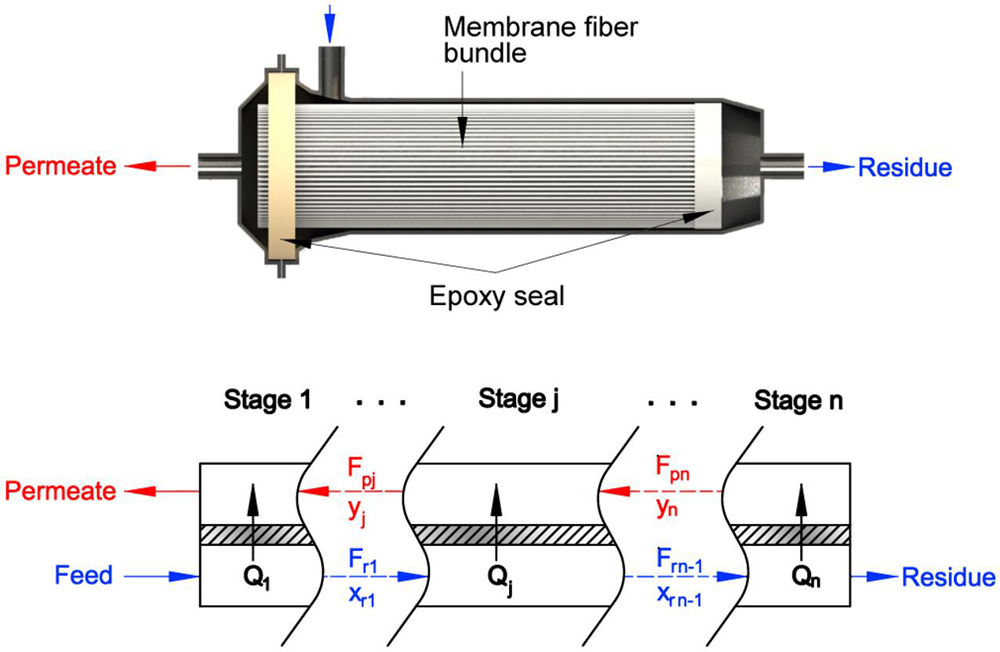

Frontiers of Chemical Science and Engineering >
Integration of molecular dynamic simulation and free volume theory for modeling membrane VOC/gas separation
Received date: 29 Oct 2017
Accepted date: 22 Dec 2017
Published date: 09 May 2018
Copyright
Gas membrane separation process is highly unpredictable due to interacting non-ideal factors, such as composition/pressure-dependent permeabilities and real gas behavior. Although molecular dynamic (MD) simulation can mimic those complex effects, it cannot precisely predict bulk properties due to scale limitations of calculation algorithm. This work proposes a method for modeling a membrane separation process for volatile organic compounds by combining the MD simulation with the free volume theory. This method can avoid the scale-up problems of the MD method and accurately simulate the performance of membranes. Small scale MD simulation and pure gas permeation data are employed to correlate pressure-irrelevant parameters for the free volume theory; by this approach, the microscopic effects can be directly linked to bulk properties (non-ideal permeability), instead of being fitted by a statistical approach. A lab-scale hollow fiber membrane module was prepared for the model validation and evaluation. The comparison of model predictions with experimental results shows that the deviations of product purity are reduced from 10% to less than 1%, and the deviations of the permeate and residue flow rates are significantly reduced from 40% to 4%, indicating the reliability of the model. The proposed method provides an efficient tool for process engineering to simulate the membrane recovery process.

Bo Chen , Yan Dai , Xuehua Ruan , Yuan Xi , Gaohong He . Integration of molecular dynamic simulation and free volume theory for modeling membrane VOC/gas separation[J]. Frontiers of Chemical Science and Engineering, 2018 , 12(2) : 296 -305 . DOI: 10.1007/s11705-018-1701-3
| 1 |
Li B, He G, Jiang X, Dai Y, Ruan X. Pressure swing adsorption/membrane hybrid processes for hydrogen purification with a high recovery. Frontiers of Chemical Science and Engineering, 2016, 10(2): 255–264
|
| 2 |
Belaissaoui B, Le Moullec Y, Favre E. Energy efficiency of a hybrid membrane/condensation process for VOC (Volatile Organic Compounds) recovery from air: A generic approach. Energy, 2016, 95(Supplement C): 291–302
|
| 3 |
Ruan X, Wang H, Dai Y, Yan X, Zhang N, Jiang X, He G. Polyimide membrane system for TFE recovery: Industrial plant, optimal operation and economic analysis. Separation and Purification Technology, 2017, 188: 468–475
|
| 4 |
Yeom C K, Lee S H, Song H Y, Lee J M. Vapor permeations of a series of VOCs/N2 mixtures through PDMS membrane. Journal of Membrane Science, 2002, 198(1): 129–143
|
| 5 |
Yun C M, Akiyama E, Yamanobe T, Uehara H, Nagase Y. Characterizations of PDMS-graft copolyimide membrane and the permselectivity of gases and aqueous organic mixtures. Polymer, 2016, 103(Supplement C): 214–223
|
| 6 |
Chen B, Ruan X, Jiang X, Xiao W, He G. Dual-membrane module and its optimal flow pattern for H2/CO2 separation. Industrial & Engineering Chemistry Research, 2016, 55(4): 1064–1075
|
| 7 |
Chen B, Ruan X, Xiao W, Jiang X, He G. Synergy of CO2 removal and light hydrocarbon recovery from oil-field associated gas by dual-membrane process. Journal of Natural Gas Science and Engineering, 2015, 26: 1254–1263
|
| 8 |
Chen B, Jiang X, Xiao W, Dong Y, Hamouti I E, He G. Dual-membrane natural gas pretreatment process as CO2 source for enhanced gas recovery with synergy hydrocarbon recovery. Journal of Natural Gas Science and Engineering, 2016, 34: 563–574
|
| 9 |
Merkel T C, Bondar V I, Nagai K, Freeman B D, Pinnau I. Gas sorption, diffusion, and permeation in poly(dimethylsiloxane). Journal of Polymer Science. Part B, Polymer Physics, 2000, 38(3): 415–434
|
| 10 |
Fujita H, Kishimoto A. Interpretation of viscosity data for concentrated polymer solutions. Journal of Chemical Physics, 1961, 34(2): 393–398
|
| 11 |
Stern S A, Mauze G R, Frisch H L. Tests of a free-volume model of gas permeation through polymer membranes. I. Pure CO2, CH4, C2H4, and C3H8 in polyethylene. Journal of Polymer Science. Part B, Polymer Physics, 1983, 21(8): 1275–1298
|
| 12 |
Scholes C A, Stevens G W, Kentish S E. Modeling syngas permeation through a poly dimethyl siloxane membrane by Flory-Rehner theory. Separation and Purification Technology, 2013, 116: 13–18
|
| 13 |
Petropoulos J H. Plasticization effects on the gas permeability and permselectivity of polymer membranes. Journal of Membrane Science, 1992, 75(1): 47–59
|
| 14 |
Lammers L N, Bourg I C, Okumura M, Kolluri K, Sposito G, Machida M. Molecular dynamics simulations of cesium adsorption on illite nanoparticles. Journal of Colloid and Interface Science, 2017, 490: 608–620
|
| 15 |
Kozuch J D, Zhang W, Milner T S. Predicting the Flory-Huggins c parameter for polymers with stiffness mismatch from molecular dynamics simulations. Polymers, 2016, 8(6): 241
|
| 16 |
Feng X S, Shao P H, Huang R Y M, Jiang G L, Xu R X. A study of silicone rubber/polysulfone composite membranes: Correlating H2/N2 and O2/N2 permselectivities. Separation and Purification Technology, 2002, 27(3): 211–223
|
| 17 |
Liu L, Jiang N, Burns C M, Chakma A, Feng X. Substrate resistance in composite membranes for organic vapour/gas separations. Journal of Membrane Science, 2009, 338(1-2): 153–160
|
| 18 |
Scholes C A, Stevens G W, Kentish S E. The effect of hydrogen sulfide, carbon monoxide and water on the performance of a PDMS membrane in carbon dioxide/nitrogen separation. Journal of Membrane Science, 2010, 350(1-2): 189–199
|
| 19 |
Poling B E, Prausnitz J M, O’Connell J P. The Properties of Gases and Liquids.New York: McGraw-hill, 2001, 915–929
|
| 20 |
Stern S A, Saxena V. Concentration-dependent transport of gases and vapors in glassy polymers. Journal of Membrane Science, 1980, 7(1): 47–59
|
/
| 〈 |
|
〉 |